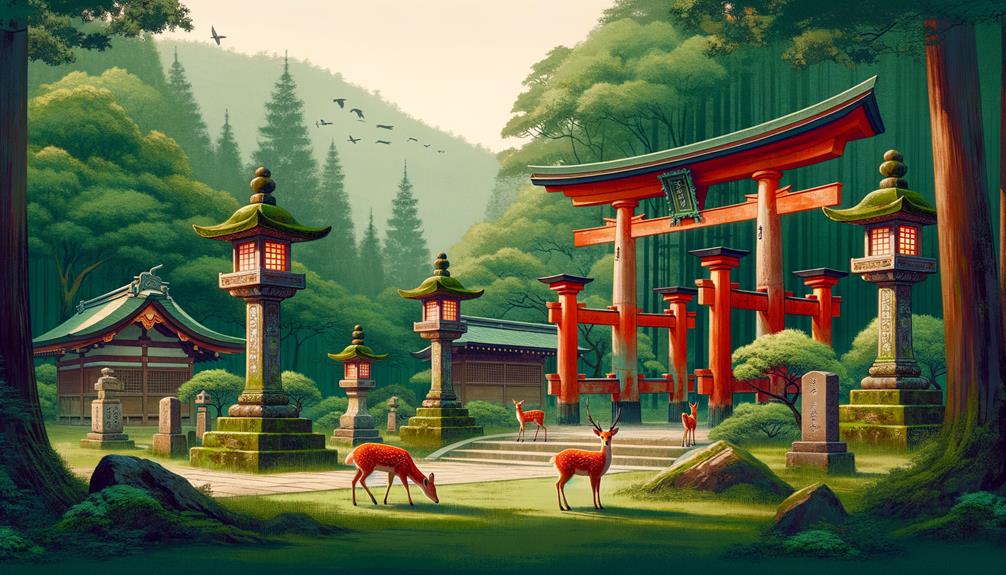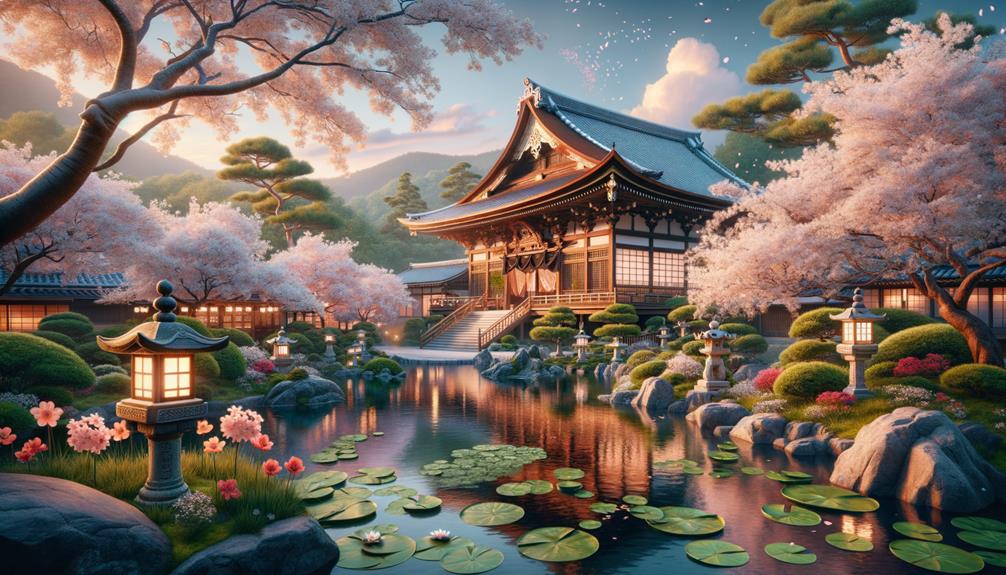Stepping through the gates of Nara Kasuga Taisha Shrine, I instantly felt a deep sense of history and spirituality wash over me. The shrine's beautiful Kasuga-zukuri architecture, with its bright vermilion colors and elegantly sloping roofs, caught my eye right away. Thousands of stone and bronze lanterns, each a testament to centuries of devotion, lined the pathways and cast a soft, serene glow. As I wandered further into the grounds, the peaceful sounds of nature from the nearby Kasugayama Primeval Forest added to the shrine's calming atmosphere. There's something about this place that makes you stop and reflect—it's like stepping into a living piece of Japan's ancient heritage.
History and Origins
Kasuga Taisha Shrine has a rich history that goes back to 768, when Fujiwara-no-Nagate established it, honoring four main deities, including Takemikazuchi-no-mikoto. Walking through the ancient grounds feels like stepping into the Tempyo Culture period, a time full of grandeur and mystery. Empress Shotoku, with her forward-thinking vision, ordered the shrine's construction, making it a key site for the Fujiwara clan and the imperial family. The bright vermilion buildings, now recognized as a UNESCO World Heritage Site, are a testament to their lasting influence.
Exploring the grounds, I was awestruck by the 3,000 lanterns that line the paths and buildings. Their gentle light at night must create a magical and peaceful atmosphere. Every 20 years, the Shikinen Zotai ceremony takes place, renewing the shrine's buildings, tools, and sacred practices. This commitment to tradition is evident, as each renewal seems to breathe fresh life into Kasuga Taisha.
Thinking about the shrine's beginnings, I felt a deep admiration for the Fujiwara clan's dedication. Their legacy, deeply connected with the shrine's history, continues to inspire those looking for a sense of freedom in tradition and respect.
Religious Significance
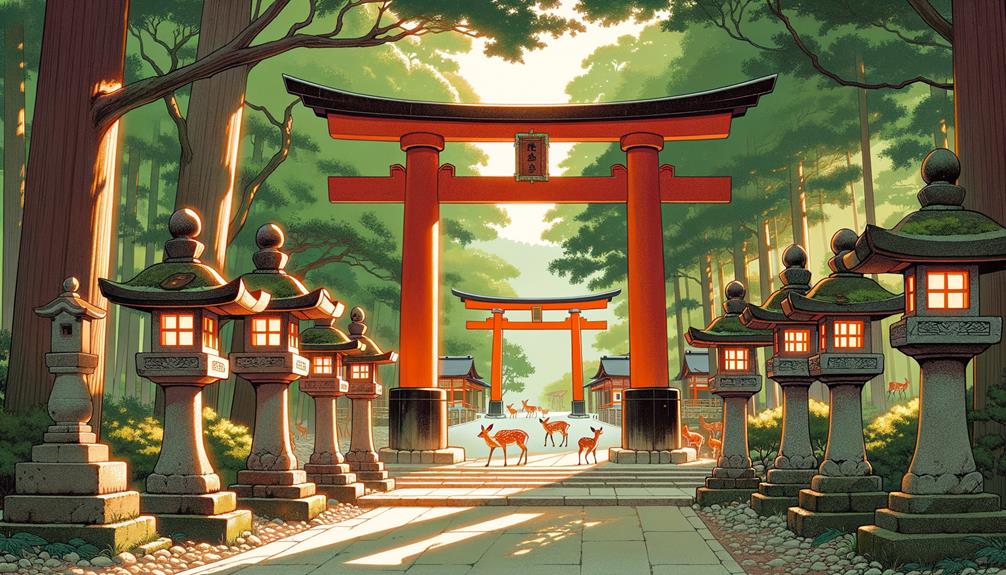
As I walked through the shrine's sacred grounds, I couldn't help but feel the deep spiritual energy that comes from the four main deities enshrined here: Futsunushi-no-mikoto, Amenokoyane-no-mikoto, Kasuga Daimyōjin, and Ame-no-Oshikumoneja. These gods give the entire Kasuga Taisha Shrine a sense of reverence and sanctity.
The shrine's religious significance is deeply tied to its ancient traditions and rituals. One notable practice is the Shikinen Zotai ceremony, where the shrine is rebuilt every 20 years. This ceremony preserves the structure and refreshes its spiritual essence, maintaining the bond between the divine and the earthly.
During the Lantern Festivals, like Setsubun Mantoro and Chugen Mantoro, the shrine is lit up by thousands of lanterns, each carrying wishes and prayers. Visitors, including myself, take part in traditional shrine activities like writing wishes on ema (wooden plaques) and attaching them to lanterns for blessings. This act of faith creates a tangible connection to the spiritual world, making Kasuga Taisha Shrine a profound place for worship, reflection, and hope.
Architectural Features
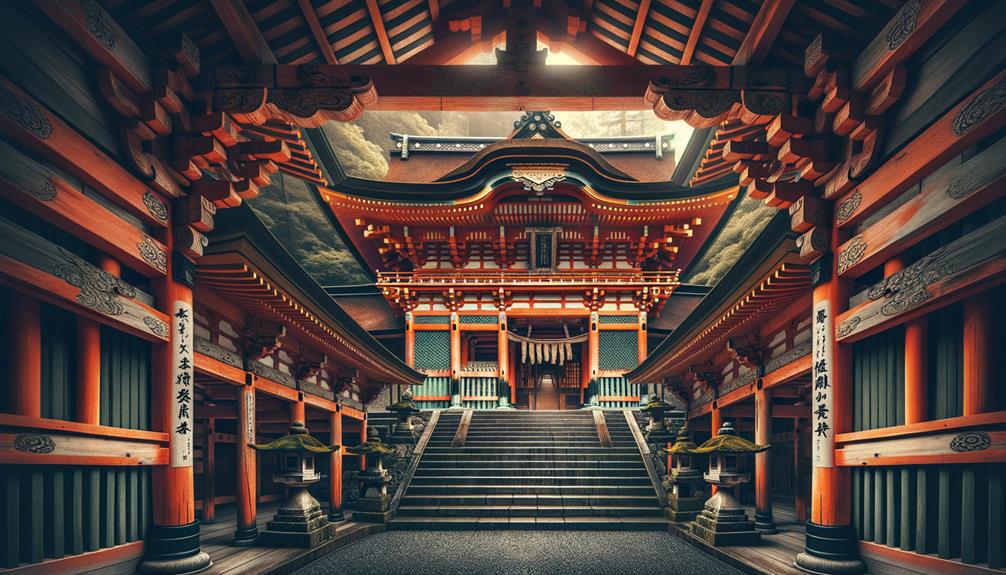
Walking through the shrine, I was struck by the vibrant red columns, white walls, and cedar bark roofs that characterize the kasuga-zukuri architectural style of this sacred place. Kasuga Taisha's beauty is further emphasized by the detailed sanctuaries housing its four main deities, each recognized as a national treasure. These structures showcase the refined building techniques from the Nara and Heian periods, standing as timeless symbols of tradition.
Strolling along the oaimichi path, the nearly 3,000 stone lanterns caught my eye. Many date back to the Muromachi period, their weathered surfaces whispering stories of centuries past. These stone lanterns, with wooden fire boxes, create a captivating play of light and shadow, especially as evening approaches.
The corridors of Kasuga Taisha, adorned with over 1,000 lanterns donated by devotees, exude a serene and sacred ambiance. Each lantern reflects the enduring spirit of the shrine, lighting the way for countless pilgrims. This harmonious blend of nature and architecture at Kasuga Taisha fosters a deep sense of peace and freedom, inviting thoughtful reflection at every turn.
Festivals and Events
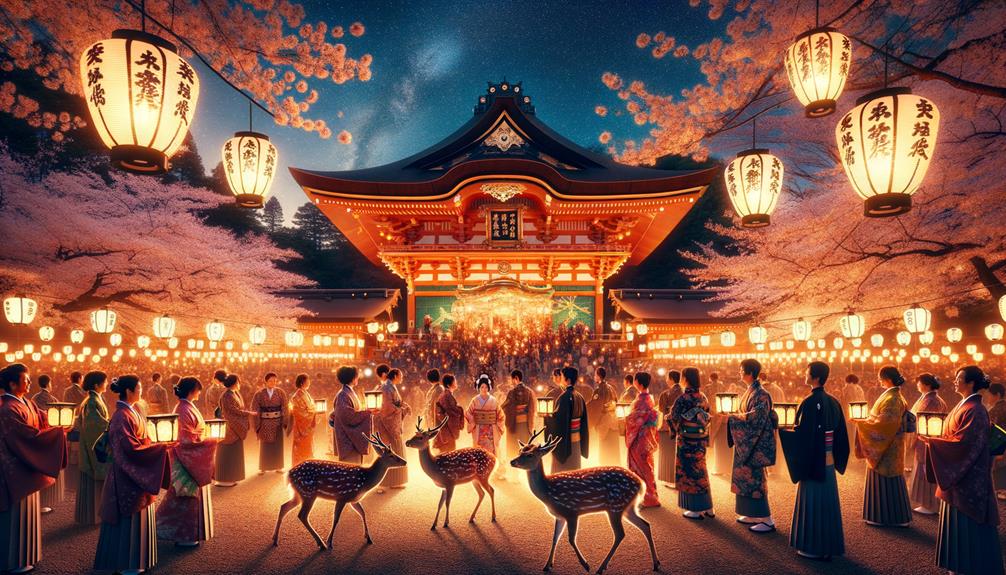
Amid the lively celebrations at Kasuga Taisha, I was amazed by the ancient traditions that come to life during the Setsubun Mantoro and Chugen Mantoro festivals. About 3,000 lanterns light up the shrine twice a year, their warm glow creating a magical and timeless atmosphere.
These festivals offer a deep connection to traditional Japanese culture. During the Kasuga Matsuri, I was captivated by dancers performing gagaku and bugaku, their movements rich with history. The Kasuga Wakamiya Festival, aimed at preventing diseases and encouraging new growth, brought together a vibrant crowd of locals and tourists, all hoping for a bright future.
A unique custom at Kasuga Taisha involves attaching Ema boards, where visitors write their wishes, to lanterns. This personal touch adds meaning to the prayers for peace and happiness.
| Festival | Purpose | Unique Aspect |
|---|---|---|
| Setsubun Mantoro | Lantern Illumination | 3,000 lanterns |
| Chugen Mantoro | Lantern Illumination | 3,000 lanterns |
| Kasuga Matsuri | Traditional Dance | Gagaku and bugaku performances |
| Kasuga Wakamiya Festival | Disease Prevention, New Growth | Community participation |
Experiencing these festivals provided a deep connection to the essence of Kasuga Taisha, blending spirituality with cultural celebration.
Kasugayama Primeval Forest

As I wander through Kasugayama Primeval Forest, the sense of history and reverence is palpable. Protected since 841 CE, this ancient forest embodies the sacred bond between nature and the Kasuga Taisha Shrine. The diverse plant and animal life, along with the stone lanterns lining the path, create a serene and spiritual atmosphere that's hard to miss.
Historical Conservation Efforts
The ancient trees of Kasugayama Primeval Forest, sheltered from hunting and logging since 841 CE, stand as timeless guardians of Nara's sacred heritage. Walking through this revered land, the weight of history and the dedication to preserving its sanctity is palpable. The forest, closely tied to the Kasuga Taisha Shrine, has played a crucial role in the spiritual practices here for over a thousand years.
The efforts to keep this forest untouched are truly impressive. It's about more than just protecting trees—it's about preserving a living piece of Japan's cultural heritage. Each ancient tree in Kasugayama Primeval Forest is a symbol of deep respect, connected to the shrine's sacred landscape. These conservation efforts show a profound reverence for both nature and spirituality, ensuring that the forest remains a link to the past.
Nara's commitment to this area highlights its importance. By preserving the forest, we honor the intricate relationship between the natural world and the divine, a connection deeply rooted in Japanese traditions and texts. The Kasugayama Primeval Forest remains a pristine sanctuary, reflecting our ongoing dedication to historical conservation.
Sacred Flora and Fauna
Walking through Kasugayama Primeval Forest, I'm struck by the sacred plants and animals that bring this ancient place to life. The tall trees, untouched since 841 CE, create a canopy that feels almost magical. Every step feels like entering a space where nature and spirituality blend effortlessly.
The forest's symbolic presence is unmistakable. It's not just trees and wildlife; it's a living testament to the divine. Sacred deer, seen as messengers of the gods, roam freely, adding to the spiritual atmosphere. These animals, along with the rich plant life, confirm the divine beings worshipped at Kasuga Taisha Shrine.
Standing in this natural haven, I'm reminded of how the forest is depicted in Japanese mandalas, showcasing its vital role in local spiritual life. The sacred plants and animals aren't just part of the scenery; they hold deep, mystical meaning that's been carefully preserved for centuries.
In Kasugayama Primeval Forest, nature and spirituality come together, offering a profound sense of freedom and connection to the divine.
Visitor Information
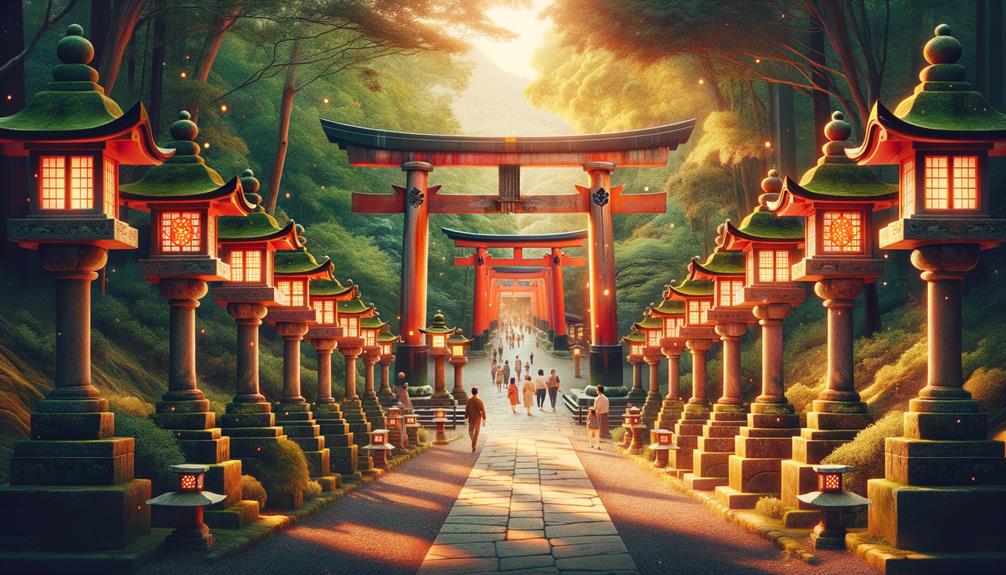
In the peaceful stretch of Nara Park, Kasuga Taisha Shrine beckons visitors to wander through its historic grounds and soak in the rich cultural history of ancient Japan. Nestled at the base of Mount Mikasa, this UNESCO World Heritage Site stands proudly alongside the nearby Tōdaiji and Kōfukuji temples. The main shrine, cherished by the Fujiwara clan, has been a symbol of devotion for centuries, with Empress Shōtoku commissioning the construction of its worship hall.
As I stroll through Nara Park, the sight of white deer, seen as messengers of the deity Takemikazuchi-no-mikoto, catches my eye. The blend of nature and spirituality is striking, with these sacred deer roaming freely and bringing to life the shrine's ancient legends.
Reaching Kasuga Taisha from Nara Station is a breeze, whether you choose a scenic walk or a quick bus ride. The shrine is open all year, with each season offering a different kind of beauty, from spring's cherry blossoms to the vivid autumn leaves. Whether you're after historical insights or a peaceful escape, Kasuga Taisha provides a deep connection to Japan's cultural heritage.
Frequently Asked Questions
Is It Worth Visiting Kasuga Taisha Shrine?
Stepping into Kasuga Taisha Shrine feels like traveling back to the 8th century. The bright vermilion structures, the magical lantern festival, and the rare Shikinen Zotai ceremony make it a fascinating blend of history and culture. Definitely worth a visit!
What Is the Kasuga Taisha Shrine Famous For?
Kasuga Taisha Shrine is well-known for its thousands of stone lanterns, creating a magical atmosphere. The vibrant vermilion columns and cypress roofs are stunning. The Mantoro Festival, where 3,000 lanterns are lit, is absolutely breathtaking.
How Do You Get to the Kasuga Taisha Shrine?
To reach the Kasuga Taisha Shrine, you can either take a pleasant walk from Kintetsu Nara Station or hop on a bus to the nearest stop. If you're coming from JR Nara Station, it's about a 30-minute stroll through the beautiful Nara Park.
How Much Does It Cost to Go to the Shrines at Kasuga Taisha?
Strolling through the peaceful shrines doesn't cost a thing, but they do appreciate donations. Some special ceremonies and events might have fees. Reflecting on this, I feel a sense of freedom and peace in this spiritual experience.

